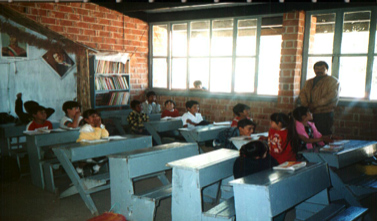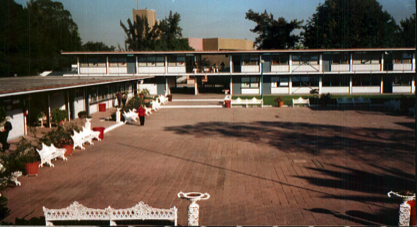Education in Mexico
Pre-school (Preescolar)
Pre-School (Preescolar) consists of one to three grades serving children from three to five years old. It is a national priority that all children will attend at least one year of Pre-school, even though it is not a pre-requisite for Primary. Age is the only criterion for advancing from the first year to the second, from the second to the third, or for entering Primary School. Pre-school is considered a link between the home and Primary School. The goals are the following:
- To prevent and detect developmental problems that may interfere with the child’s learning
- To increase the child’s vocabulary and coordination
- To promote and develop attitudes that will facilitate socialization
Elementary School (Primaria)
Grades 1 - 6

Elementary school is obligatory. It serves children who are from six years to 14 years old in six grade levels. Upon conclusion of the sixth grade the student is awarded a certificate that confirms his or her readiness to continue at the middle school level.
General elementary education is provided in public and private schools. Indigenous elementary schools may be located in indigenous rural communities and suburban settlements. Materials are adapted for at least 30 different languages and the people who speak them.
You can read more about indigenous education.
Community classes are conducted by the federal government in communities which, because of their scarce population and isolation, are not served by state schools. All are escuelas unitarias (one instructor for all grade levels). They are organized and staffed by a federal agency, the National Council for the Promotion of Education Consejo Nacional de Fomento Educativo (CONAFE).
You can read more about escuelas unitarias.
The federal government also offers adult Elementary education and adult literacy classes through the National Institute for the Education of Adults, Instituto Nacional de Educación de Adultos (INEA), which meet in the evening in school buildings, homes, churches, factories, or other facilities. Adults may also study for a nElementary diploma in Centers for Basic Education for Adults, Centros de Educación Basica para Adultos (CEBA), Centers for Non-Formal Education Centros de Educación Extraescolar (CEDEX) and Cultural Missions, Misiones Culturales (MC). Credit is by examination. The INEA also provides services in the United States.
Your Mexican Consulate can provide more information. Every public and private elementary school uses common plans and programs of study, free student textbooks, and support materials for teachers, all written and disseminated nationally by the SEP. States may publish and use supplementary texts for state history, culture, and geography. The SEP has published a series of state monographs, also intended for use with the Elementary school curriculum. Elementary schools may operate on one, two, or three sessions. The schedule is national:
- Morning session: 8:00 a.m. until 12:30 p.m.
- Afternoon session: 2:00 p.m. until 6:30 p.m.
- Evening session: 7:00 p.m. until 9:00 p.m.
Each session is operated as a separate school. The same or some of the same educators may serve as the principal or faculty members in more than one session. In mountainous rural areas, cold mornings may prompt a much later starting time. There usually is only one session in more remote places. Students usually study Spanish and mathematics at the beginning of the school day.
 Rural Primaria in Jalisco
Rural Primaria in Jalisco
During the first two grades, 45 percent of class time is devoted to Spanish. The school day includes a recess, during which students may play in the patio area and eat a snack. Children bring something from home or buy food such as eggs, French fries, ice cream, or fruit from the school "Cooperative." The Cooperativa Escolar (Cooperative) is an organization of students and teachers formed in accordance with national regulations, supported by the Parents' Association, and supervised by the school principal. The "Cooperative" elects officers and forms committees. The profits are divided among the school and members of the "Cooperative."
Student discipline must conform to national norms. Teachers have Elementary responsibility for maintaining order and may call in a parent if the child misbehaves. The principal becomes involved if the matter is not settled or in the event of a serious problem. Individual schools have the authority to suspend or even expel students.
Extra-curricular activities include field trips for which the students pay, clubs, and participation in community events. Clubs involve students in dance, drawing, singing, reading, or sports. They sometimes function during a special activity time during the school day on Fridays, or they may be organized after school hours.
There is an effort in Mexican schools to conserve folklore and traditions. Every Monday there is a ceremony to salute the flag, and a civic festival is scheduled for each month. Participation in public civic ceremonies is particularly important in rural areas, where the school, along with the church, often serves as the location for many community events. For instance, the community may use the school for town fiestas, as voting centers, for shelters in the event of a natural disaster, or as vaccination centers during campaigns by federal public health officials.
There are neither required attendance zones in Mexico nor state-paid bus service although some private schools offer transportation. In rural areas children may have to walk a long way, as much as1 - 2 miles, to attend school. Some arrive on horseback.
Middle School (Secundaria)
Grades 7, 8, 9
Middle School (Secundaria) serves children and adults who have completed Elementary education. There are three years of studies called "first grade," "second grade," and "third grade," serving students from 12 to 16 years old. It is tuition-free, and since 1993 obligatory.
According to the SEP, an estimated 75 percent of the young people who enroll in Middle School complete the three year program (Programa Nacional de Educación 2001-2006 69). Retention and drop out remain serious concerns.
You can read more about the four types of middle school education.
You can also read a summary of middle school policies in Mexico.
As with elementary education, the SEP determines the school calendar, plans, and programs of study. Schools must select their texts from a list approved by the SEP. Beginning school year 1997-1998, the SEP began distributing free textbooks to the poorest municipalities. By the 2000-2001 school term, all secondary students received free texts. Secondary buildings may be used by the community for special events such as town fiestas, shelters during natural disasters, Telesecundaria, adult education classes, and public health campaigns.
Since 1994, the SEP has provided schools with books called Collection of Books for Secondary Schools (Colección de Libros para Escuelas Secundarias). It consists of 180 titles including reference books such as an atlas, an encyclopedia, and a dictionary in addition to science, geography, health, recreation, as well as Mexican and world literature books. The Rincones de Lectura (Reading Corners) federal book donation program was recently expanded to include secondary level schools. For free copies of these books, contact your local consulate.
 Urban Secundaria
Urban Secundaria
The school principal is responsible for the organization, operation, and administration of the school. He or she may be assisted by an assistant principal and a school secretary, whose job is more like an administrative assistant. There may also be personnel called prefectos, who assist with discipline and who may serve as substitute teachers. As in Elementary schools, there is a School Technical Consultative Council, which advises and assists with school operations. In schools with large faculties, teachers may be divided into "academies," which operate much like departments in United States schools.
Although the majority of Secundarias are co-educational, there are still schools where only boys or girls attend. There may be one, two, or three sessions. Each session is considered a separate school.
Schedules may be adjusted with classes starting later because of cold climates or earlier because of the heat. In Mexico City schools, adjustments sometimes are necessary because of a "pollution alert." As in Elementary schools, there is a break during the day for students to relax and eat a snack.
At the middle school level, the teachers change classrooms, not the students, with the exception of vocational classes, labs, or physical education. Although discipline is regulated by national norms, administrative and instructional staff may establish rules particular to an individual school. School staff will inform parents and request a conference if the student continues to misbehave. The principal is the ultimate authority in the school and has the authority to suspend or even expel students for repeated or serious offenses.
High School (Bachillerato)
Grades 10, 11, 12
Upper Middle Education (Educación Media Superior) follows middle school (Secundaria) and includes academic high school (Bachillerato General) as well as purely vocational programs of study called Professional Technical Education (Educación Profesional Técnica). In school year 1998-1999, more than 58 percent of the upper middle school students were enrolled in academic high school, 14.4 percent were enrolled in technical professional, and 27.4 percent studied technological high school (Perfil de la Educación en México, p.71).
Historically there has been great diversity in the plans and programs of study, to the extent that it was often impossible for a student to transfer from one bachillerato to another. In its “Program for Educational Modernization 1989-1994,” the Secretariat of Public Education (SEP) promoted national norms. In accordance with federal Resolutions 71 and 77, all accredited Mexican bachilleratos should have met the following minimum requirements beginning school year 1994-1995:
- A three-year program of studies divided into six semesters
- Curricula divided into three general areas:
- a core curriculum
- university preparatory classes related to the planned field of study
- vocational electives
- A minimum of 15 weeks per semester
However, the SEP estimates that there still are more than 500 different plans of study.
Approximately 47 percent of youth ages 16-18 attend these Upper Middle schools. The low rate of enrollment is the result of retention and drop out at the elementary and middle school levels, as well as the number of students who do not complete this level of education. (Programa Nacional de Educación, 2001-2006, p.60).
Changes in demographic patterns, indicating a rapid growth of the 15-24 year old age group, along with the exigencies of the global economy and technology, have focused more attention on this level of education (Programa Nacional de Educación, 2001-2006, p.36). The SEP has proposed the creation of a new administrative department to coordinate Upper Middle Education and has proposed a number of strategies to expand and strengthen high schools. These include: financial and institutional support, especially for public institutions; a system of scholarships; curricular reform; teacher training; and ongoing evaluation (Programa Nacional de Educación, 2001-2006, p.182).
Bachillerato is a three or four year program of study, generally attended by youth 15 to 18 years old. Professional technical education may consist of two to four years of study, is terminal and, therefore, does NOT qualify graduates for admission to a university. Any school called Bachillerato is university preparatory. The programs of study may be organized by specialization; for more information please read about the types of Mexican high schools.
Higher Education
Higher education follows high school. It is offered in four different types of institutions: universities, technological institutes, teacher training colleges called Normal Schools, and technological universities. The total population enrolled in higher education is 2,239,000 students. Approximately, 67 percent of them are enrolled in public institutions.
In school year 2000-2001, more than 68 percent of the total number of students was enrolled at public institutions (Programa Nacional de Educación, 2001-2006, p. 186).
Teacher Training
In 1984, teacher training (Normal) was incorporated into higher education. Aspiring teachers may complete undergraduate degrees in pre-school, elementary and middle school education, as well as physical and special education. Graduate level studies include master’s and doctoral level studies. Teaching colleges operate under the jurisdiction of the SEP or the state governments, exist as private institutions, or function under the auspices of the National Pedagogical University.